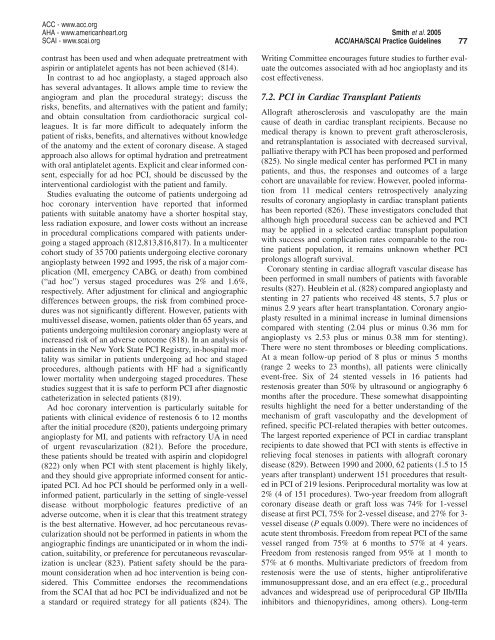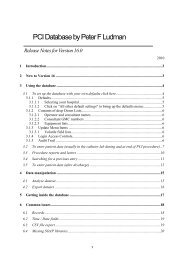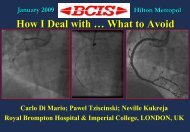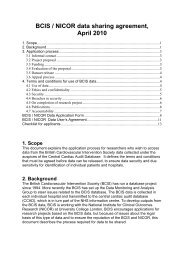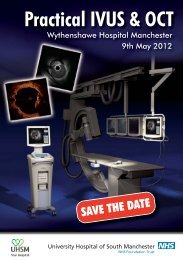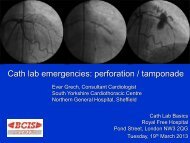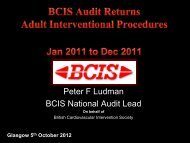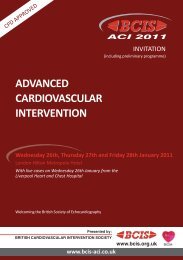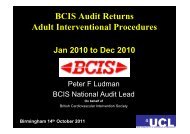Recommendations
ACC/AHA/SCAI PCI Guidelines - British Cardiovascular Intervention ...
ACC/AHA/SCAI PCI Guidelines - British Cardiovascular Intervention ...
- No tags were found...
You also want an ePaper? Increase the reach of your titles
YUMPU automatically turns print PDFs into web optimized ePapers that Google loves.
ACC - www.acc.org<br />
AHA - www.americanheart.org<br />
SCAI - www.scai.org<br />
Smith et al. 2005<br />
ACC/AHA/SCAI Practice Guidelines<br />
77<br />
contrast has been used and when adequate pretreatment with<br />
aspirin or antiplatelet agents has not been achieved (814).<br />
In contrast to ad hoc angioplasty, a staged approach also<br />
has several advantages. It allows ample time to review the<br />
angiogram and plan the procedural strategy; discuss the<br />
risks, benefits, and alternatives with the patient and family;<br />
and obtain consultation from cardiothoracic surgical colleagues.<br />
It is far more difficult to adequately inform the<br />
patient of risks, benefits, and alternatives without knowledge<br />
of the anatomy and the extent of coronary disease. A staged<br />
approach also allows for optimal hydration and pretreatment<br />
with oral antiplatelet agents. Explicit and clear informed consent,<br />
especially for ad hoc PCI, should be discussed by the<br />
interventional cardiologist with the patient and family.<br />
Studies evaluating the outcome of patients undergoing ad<br />
hoc coronary intervention have reported that informed<br />
patients with suitable anatomy have a shorter hospital stay,<br />
less radiation exposure, and lower costs without an increase<br />
in procedural complications compared with patients undergoing<br />
a staged approach (812,813,816,817). In a multicenter<br />
cohort study of 35 700 patients undergoing elective coronary<br />
angioplasty between 1992 and 1995, the risk of a major complication<br />
(MI, emergency CABG, or death) from combined<br />
(“ad hoc”) versus staged procedures was 2% and 1.6%,<br />
respectively. After adjustment for clinical and angiographic<br />
differences between groups, the risk from combined procedures<br />
was not significantly different. However, patients with<br />
multivessel disease, women, patients older than 65 years, and<br />
patients undergoing multilesion coronary angioplasty were at<br />
increased risk of an adverse outcome (818). In an analysis of<br />
patients in the New York State PCI Registry, in-hospital mortality<br />
was similar in patients undergoing ad hoc and staged<br />
procedures, although patients with HF had a significantly<br />
lower mortality when undergoing staged procedures. These<br />
studies suggest that it is safe to perform PCI after diagnostic<br />
catheterization in selected patients (819).<br />
Ad hoc coronary intervention is particularly suitable for<br />
patients with clinical evidence of restenosis 6 to 12 months<br />
after the initial procedure (820), patients undergoing primary<br />
angioplasty for MI, and patients with refractory UA in need<br />
of urgent revascularization (821). Before the procedure,<br />
these patients should be treated with aspirin and clopidogrel<br />
(822) only when PCI with stent placement is highly likely,<br />
and they should give appropriate informed consent for anticipated<br />
PCI. Ad hoc PCI should be performed only in a wellinformed<br />
patient, particularly in the setting of single-vessel<br />
disease without morphologic features predictive of an<br />
adverse outcome, when it is clear that this treatment strategy<br />
is the best alternative. However, ad hoc percutaneous revascularization<br />
should not be performed in patients in whom the<br />
angiographic findings are unanticipated or in whom the indication,<br />
suitability, or preference for percutaneous revascularization<br />
is unclear (823). Patient safety should be the paramount<br />
consideration when ad hoc intervention is being considered.<br />
This Committee endorses the recommendations<br />
from the SCAI that ad hoc PCI be individualized and not be<br />
a standard or required strategy for all patients (824). The<br />
Writing Committee encourages future studies to further evaluate<br />
the outcomes associated with ad hoc angioplasty and its<br />
cost effectiveness.<br />
7.2. PCI in Cardiac Transplant Patients<br />
Allograft atherosclerosis and vasculopathy are the main<br />
cause of death in cardiac transplant recipients. Because no<br />
medical therapy is known to prevent graft atherosclerosis,<br />
and retransplantation is associated with decreased survival,<br />
palliative therapy with PCI has been proposed and performed<br />
(825). No single medical center has performed PCI in many<br />
patients, and thus, the responses and outcomes of a large<br />
cohort are unavailable for review. However, pooled information<br />
from 11 medical centers retrospectively analyzing<br />
results of coronary angioplasty in cardiac transplant patients<br />
has been reported (826). These investigators concluded that<br />
although high procedural success can be achieved and PCI<br />
may be applied in a selected cardiac transplant population<br />
with success and complication rates comparable to the routine<br />
patient population, it remains unknown whether PCI<br />
prolongs allograft survival.<br />
Coronary stenting in cardiac allograft vascular disease has<br />
been performed in small numbers of patients with favorable<br />
results (827). Heublein et al. (828) compared angioplasty and<br />
stenting in 27 patients who received 48 stents, 5.7 plus or<br />
minus 2.9 years after heart transplantation. Coronary angioplasty<br />
resulted in a minimal increase in luminal dimensions<br />
compared with stenting (2.04 plus or minus 0.36 mm for<br />
angioplasty vs 2.53 plus or minus 0.38 mm for stenting).<br />
There were no stent thromboses or bleeding complications.<br />
At a mean follow-up period of 8 plus or minus 5 months<br />
(range 2 weeks to 23 months), all patients were clinically<br />
event-free. Six of 24 stented vessels in 16 patients had<br />
restenosis greater than 50% by ultrasound or angiography 6<br />
months after the procedure. These somewhat disappointing<br />
results highlight the need for a better understanding of the<br />
mechanism of graft vasculopathy and the development of<br />
refined, specific PCI-related therapies with better outcomes.<br />
The largest reported experience of PCI in cardiac transplant<br />
recipients to date showed that PCI with stents is effective in<br />
relieving focal stenoses in patients with allograft coronary<br />
disease (829). Between 1990 and 2000, 62 patients (1.5 to 15<br />
years after transplant) underwent 151 procedures that resulted<br />
in PCI of 219 lesions. Periprocedural mortality was low at<br />
2% (4 of 151 procedures). Two-year freedom from allograft<br />
coronary disease death or graft loss was 74% for 1-vessel<br />
disease at first PCI, 75% for 2-vessel disease, and 27% for 3-<br />
vessel disease (P equals 0.009). There were no incidences of<br />
acute stent thrombosis. Freedom from repeat PCI of the same<br />
vessel ranged from 75% at 6 months to 57% at 4 years.<br />
Freedom from restenosis ranged from 95% at 1 month to<br />
57% at 6 months. Multivariate predictors of freedom from<br />
restenosis were the use of stents, higher antiproliferative<br />
immunosuppressant dose, and an era effect (e.g., procedural<br />
advances and widespread use of periprocedural GP IIb/IIIa<br />
inhibitors and thienopyridines, among others). Long-term


